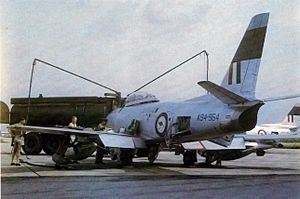Southeast Asia Treaty Organization facts for kids
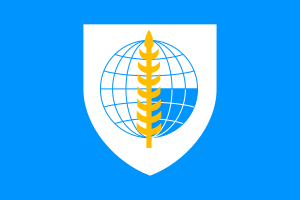
SEATO's flag
|
|

Map of SEATO members, shown in blue.
|
|
| Abbreviation | SEATO |
|---|---|
| Formation | 8 September 1954 |
| Type | Intergovernmental military alliance |
| Headquarters | Bangkok, Thailand |
|
Region served
|
Southeast Asia |
|
Membership
|
Non-members protected by SEATO 3 states
|
|
Official languages
|
|
|
Budget
|
Total: US$1.236 trillion |
| Website | http://seato.int/ |
The Southeast Asia Treaty Organization (SEATO) was an international group formed to protect countries in Southeast Asia. It was like a team of nations that promised to help each other if they were attacked. The group was officially started on February 19, 1955, in Bangkok, Thailand. Its main office was also in Bangkok. Eight countries joined this organization.
SEATO was mainly created to stop the spread of communism in Southeast Asia. Communism was a political idea that some countries, like China, followed. Many people think SEATO didn't succeed much in its military goals because its members often disagreed. However, SEATO did create some good cultural and educational programs that helped people in Southeast Asia for a long time. SEATO ended on June 30, 1977, because many countries lost interest and left the group.
Contents
Why SEATO Was Formed and How It Worked
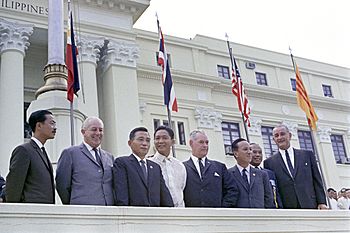
The treaty that created SEATO was signed on September 8, 1954, in Manila, Philippines. This was part of a bigger plan by the United States to create alliances against communist countries. The goal was to stop the spread of communism, especially from countries like China.
A key person behind SEATO was John Foster Dulles, who was the US Secretary of State. He wanted to expand the idea of countries working together to defend against communism into Southeast Asia. The new organization was modeled after the NATO alliance in Europe. NATO was a group where member countries' military forces worked together for defense. SEATO aimed to do something similar in Asia.
SEATO's main office was in Bangkok. It was led by a Secretary General, who was like the main boss. There was also a council with representatives from each member country and a team of international staff. The organization also had committees that focused on things like economics, security, and sharing information. The first Secretary General of SEATO was Pote Sarasin, a diplomat from Thailand.
Unlike NATO, SEATO didn't have its own standing army or joint military commands. Also, SEATO's plan for what to do if communism became a "common danger" was not very clear. This made it hard for SEATO to act quickly. Even so, being part of SEATO gave the United States a reason to send a lot of its military to the region during the Vietnam War (1955–1975).
Who Were the SEATO Members?
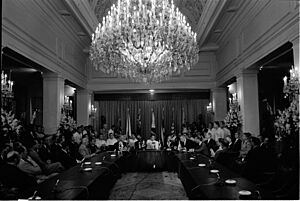
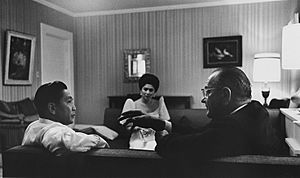
Even though it was called the "Southeast Asia Treaty Organization," most of its members were not actually in Southeast Asia. These countries had an interest in the region or in stopping communism. The members were:
Only the Philippines and Thailand were Southeast Asian countries that joined SEATO. They had strong ties with the United States and were worried about communist groups trying to take over their own governments. Thailand joined because it felt threatened by a new "Thai Autonomous Region" in China, fearing communist influence.
Other countries in the region, like Burma and Indonesia, chose not to join. They were more focused on their own internal stability than on the communist threat. Malaya (which later included Singapore) also didn't formally join, but it stayed updated because of its close relationship with the United Kingdom.
Countries like South Vietnam, Cambodia, and Laos were not allowed to join any military alliances. This was due to agreements made after the First Indochina War. However, because of the threat from communist North Vietnam, SEATO offered these countries its protection. This protection was one of the main reasons the US got involved in the Vietnam War. Cambodia, however, later refused this protection in 1956.
For Australia and New Zealand, SEATO was seen as an important group for their defense, even more so than their existing alliance with the US (ANZUS). The United Kingdom and France joined partly because they used to have colonies in the region. The United States saw SEATO as very important for its strategy to stop communism during the Cold War.
How Much Money Did Members Contribute?
Between 1958 and 1973, countries contributed to SEATO's budget in these amounts:
- United States: 24%
- United Kingdom: 16%
- France: 13.5%
- Australia: 13.5%
- Pakistan: 8%
- Philippines: 8%
- Thailand: 8%
- New Zealand: 8%
SEATO Leaders
Here are the Secretaries-General who led SEATO:
| Name | Country | From | To |
|---|---|---|---|
| Pote Sarasin | 5 September 1957 | 22 September 1958 | |
| William Worth (acting) | 22 September 1957 | 10 January 1958 | |
| Pote Sarasin | 10 January 1958 | 13 December 1963 | |
| William Worth (acting) | 13 December 1963 | 19 February 1964 | |
| Konthi Suphamongkhon [de] | 19 February 1964 | 1 July 1965 | |
| Jesus M. Vargas | 1 July 1965 | 5 September 1972 | |
| Sunthorn Hongladarom [th; de] | 5 September 1972 | 30 June 1977 |
SEATO's Military Role
After it was formed, SEATO didn't become very strong militarily. Most member countries didn't contribute much to its military power. While SEATO forces did hold joint military training exercises, they were never actually used in real conflicts because of disagreements among members. For example, SEATO couldn't get involved in conflicts in Laos because France and the United Kingdom didn't want to use military action. This meant the US had to help Laos on its own after 1962.
The United States and Australia both said their involvement in the Vietnam War was justified because of their SEATO membership. SEATO gave the US a reason to send many troops to Southeast Asia. Other countries, like the UK and some Asian nations, accepted this reason. In 1962, as part of its promise to SEATO, the Royal Australian Air Force sent its CAC Sabre fighter jets to a base in Thailand. These jets later helped protect US aircraft flying missions against North Vietnam during the war.
SEATO's Cultural and Educational Impact
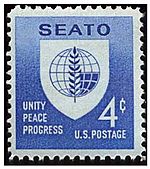
Besides military training, SEATO member countries also worked together to improve social and economic issues. These activities were managed by SEATO's Committee of Information, Culture, Education, and Labor Activities. These programs turned out to be some of SEATO's biggest successes.
In 1959, SEATO helped create the Asian Institute of Technology in Thailand. This school was built to train engineers. SEATO also supported the creation of a Teacher Development Center in Bangkok. It also helped start the Thai Military Technical Training School, which taught technical skills to workers and supervisors. SEATO's Skilled Labor Project (SLP) set up training centers for skilled workers, especially in Thailand, where 91 such workshops were created.
SEATO also gave money for research and grants in farming and medicine. In 1959, SEATO opened the Cholera Research Laboratory in Bangkok. Later, a second Cholera Research Laboratory was opened in Dacca (now Dhaka), East Pakistan. The Dacca lab quickly became a world leader in cholera research. It was later renamed the International Centre for Diarrhoeal Disease Research, Bangladesh. SEATO also supported literature and created a SEATO Literature Award for writers from member countries.
See also
- San Francisco System
- Australia, New Zealand, United States Security Treaty (ANZUS)
- Australia, United Kingdom, United States (AUKUS)
- Security Treaty Between the United States and Japan
- Mutual Defense Treaty (United States–South Korea)
- Mutual Defense Treaty (United States–Taiwan)
- Mutual Defense Treaty (United States–Philippines)
- Thanat–Rusk Communiqué
- Middle East Treaty Organization (METO)
- Northeast Asia Treaty Organization (NEATO)
- Five Power Defence Arrangements (FPDA)
- Association of Southeast Asian Nations (ASEAN)
- Free World Military Assistance Forces
- Council for Security Cooperation in the Asia Pacific


